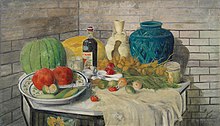Mohammed Hajji Selim
Mohammed Hajji Selim (1883-1941) was among the first generation of modern Iraqi artists to receive a European arts education. He was a talented amateur artist who produced still lifes, landscapes and portraits, most of which have not survived. He is mainly remembered as the patriarch of an artistic dynasty and as the father of the distinguished sculptor, Jawad Saleem.
Mohammed Hajji Selim | |
|---|---|
| Born | 1883 Baghdad, Iraq |
| Died | 1941 Baghdad, Iraq |
| Education | Military Academy, Istanbul |
| Known for | Painter |
| Movement | Realism |
Life and career
Mohammed Hajji Selim was born into a well-to-do family in Baghdad in 1883. His parents were both originally from Mosul in Northern Iraq. Like many of his contemporaries, Selim was educated at the Military Academy in Istanbul where drawing and painting were a standard part of the curriculum.[1] This exposure to Western art techniques, encouraged Selim to take up painting as an amateur artist. Selim was part of a group of Iraqis which included; Salim Mohammed Saleh Zaki (1888-1974), Asim Hafidh (1886- ?) and Abdul Qadir Al Rassam (1882-1952) (who may have been Selim's relative), became the first group of modern Iraqi artists to take up easel painting and generally work in the European style.[2] This group became known as the Ottomon artists and was largely responsible for stimulating an interest in Western art amongst the Iraqi population, which in turn, inspired the next generation of Iraqi artists.[3]
During the Ottoman reign, Selim became an officer in the Ottoman Army and, in the first decade of the 20th-century, he was stationed at Ankara where his youngest children were born.[4] Selim eventually settled in Baghdad in the 1920s where he worked as Government employee in Baghdad's Maidan Quarter.
He became the patriarch of an dynasty of highly talented artists; the father of contemporary artists - Rashid Salim (b. 1918); Suad Salim (b. 1918 Ankara), Jawad Saleem (b. 1920 Ankara), Nazar Selim (b. 1925 Ankara) Naziha Salim (b. 1927 Istanbul).[5] Of his children, Rashid became a painter and political cartoonist; Jawad became a painter and sculptor responsible for the monumental work known as the Nasb al-Hurriyah in Baghdad's Liberation Square; Suad became an artist and designer who designed the coat of arms for the Iraqi Republic, Nizarre was an artist and Naziha became a painter, art educator and author.[6]
Selim reportedly gave painting away after recognising the genius of his son, Jawad.[7]
Work

Selim painted in still life, portrait and landscape, but few of his paintings survived the ravages of revolution, war and looting that afflicted Iraq throughout the 20th-century. His most well-known surviving work is Still Life (pictured) painted in 1941, the same year as his death.[8]
See also
References
- Tejel, J., Writing the Modern History of Iraq: Historiographical and Political Challenges, World Scientific, 2012, p. 476
- Ali, W., Modern Islamic Art: Development and Continuity, University of Florida Press, 1997, p. 47; Dabrowska, K. and Hann, G., Iraq: The ancient sites and Iraqi Kurdistan, Bradt Travel Guides, 2015, p. 30
- Reynolds, D.F., The Cambridge Companion to Modern Arab Culture, Cambridge University Press, 2015, p.199
- Shabout, N. (ed), A Century of Iraqi Art, Bonham's of London, 2015 [Illustrated Catalog to accompany sale], Monday 20 April 2015
- Ali, W., Modern Islamic Art: Development and Continuity, University of Florida Press, 1997, p. 47; Ministry of Culture, Iraq, Culture and Arts in Iraq: Celebrating the Tenth Anniversary of the July 17–30 Revolution, Iraq, Ministry of Culture and Arts, 1978, p. 23
- Ministry of Culture, Iraq, Culture and Arts in Iraq: Celebrating the Tenth Anniversary of the July 17–30 Revolution, Iraq, Ministry of Culture and Arts, 1978, p. 23; Ali, W., Modern Islamic Art: Development and Continuity, University of Florida Press, 1997, p. 47; Ministry of Culture, Iraq, Culture and Arts in Iraq: Celebrating the Tenth Anniversary of the July 17–30 Revolution, Iraq, Ministry of Culture and Arts, 1978, p. 23
- Metcher-Atassi, S., "Munif's Interest in Modern Art, Friendship, Symbolic Exchange and the Art of the Book," The MIT Electronic Journal of Middle Eastern Studies, Spring, 2007, pp 99-116
- Bonhams Auctions, Online:; The painting sold for £ 68,500 in 2015